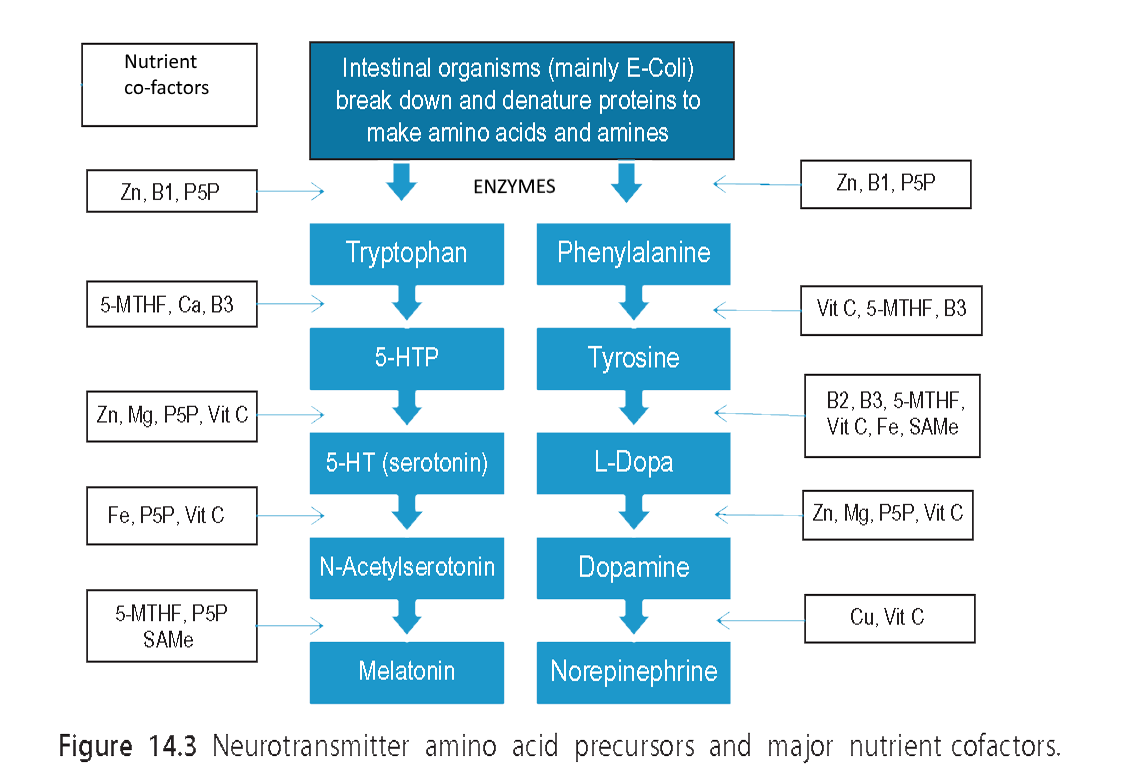Panic Attacks And Anxiety Disorders
Panic attacks and anxiety disorder have biological and psychological causes in common. There are many forms of anxiety. While some are related to stressful events, others seem to occur for no apparent reason. However, every effect has a cause. The causes of anxiety will vary from person to person. It is well-established that genetic variations, nutrient deficiencies, and dietary toxins all contribute to imbalances in brain chemicals (neurotransmitters). This is probably the reason why antidepressants and other anti-anxiety medications only treat ~40% of cases.

Recent evidence implicates the role of abnormal levels of some commensal (usually occurring) gut bacteria in the development and maintenance of anxiety disorders. These bacteria release high levels of trace amines and toxins, both of which can trigger abnormal neurotransmitter activity in the brain, leading to both anxiety and panic attacks. With this knowledge, the underlying causes can be teased out and treated, leading to more effective long-term outcomes.
Definition of Anxiety Disorders
Anxiety disorders are the most common form of mental illness in Australia. The Diagnostic and Statistical Manual of mental Disorders (DSM-V) defines various types of anxiety disorders which can be grouped under several headings. Differential diagnosis and treatment of anxiety disorders requires relevant training, skills, and experience.
Please call the clinic or see a qualified psychologist for diagnosis and treatment.
| A Panic Attack is a discrete period in which there is the sudden onset of intense apprehension, fearfulness, or terror, often associated with feelings of impending doom. During these attacks, symptoms can include shortness of breath, heart palpitations, chest pain/discomfort, choking, ‘smothering’ sensations, as well as fears of "going crazy" or losing control. |
| Agoraphobia is an anxiety or fear about, or avoidance of, places or situations from which escape might be difficult (or embarrassing) in the instance of panic-like symptoms. |
| Panic Disorder Without Agoraphobia is characterised by recurrent unexpected panic attacks of persistent concern. Panic Disorder with Agoraphobia is characterised by both recurrent unexpected panic attacks and agoraphobia. |
| Agoraphobia Without History of Panic Disorderis characterised by the presence of Agoraphobia and panic-like symptoms without a history of unexpected panic attacks. |
| Specific Phobiais characterised by clinically significant anxiety provoked by exposure to a specific feared object or situation, often leading to avoidance behaviours. |
| Social Phobia is characterised by clinically significant anxiety provoked by exposure to certain types of social or performance situations, often leading to avoidance behaviours. |
| Obsessive-Compulsive Disorder is characterised by obsessions (which cause marked anxiety or distress) and/or by compulsions (which serve to neutralise the anxiety). |
| Post-traumatic Stress Disorder is characterised by the re-experiencing of an extremely traumatic event accompanied by symptoms of increased arousal and avoidance of stimuli associated with the trauma. |
| Acute Stress Disorder is characterised by symptoms similar to those of post-traumatic stress disorder that occur immediately in the aftermath of an extremely traumatic event. |
| Generalised Anxiety Disorder is characterised by at least 6 months of persistent and excessive anxiety and worry. |
| Anxiety Disorder Due to a General Medical Condition is characterised by prominent symptoms of anxiety that are judged to be a direct physiological consequence of a general medical condition. |
| Substance-Induced Anxiety Disorder is characterised by prominent symptoms of anxiety that are judged to be a direct physiological consequence of drug abuse, medication, or toxin exposure. |
| Anxiety Disorder Not Otherwise Specified is included for coding disorders with prominent anxiety or phobic avoidance that do not meet criteria for any of the specific Anxiety Disorders defined in this section (or anxiety symptoms about which there is inadequate or contradictory information). |
Anxiety Disorders in Children & Adolescents
The DSM-V defines separation anxiety disorder as specific to children. This disorder is defined as anxiety regarding the separation from home/family that is excessive or inappropriate for the child’s age. In some children, separation anxiety takes the form of school avoidance. Children and adolescents can be diagnosed with panic disorder, phobias, generalised anxiety disorder, and post-traumatic stress disorder.

In the diagram, we can see that neurotransmitters (messenger chemicals in the brain) are made from the interactions of enzymes (proteins made by genes) and nutrient cofactors.
- Gut bacteria, mainly E-coli, break down proteins to release amino-acids (tryptophan, phenylalanine and Tyrosine).
- These amino acids are converted to neurotransmitters by enzymes made by genes (large blue arrows) with the help of nutrient co-factors (in boxes).
- Serotonin (for feel-good feelings and self-soothing) and melatonin for sleep onset and maintenance.
- Dopamine and norepinephrine are essential for the attentional system, enabling us to focus, concentrate, and be free of distractions.
What Triggers Panic Anxiety Attacks in Kids & Children?
In simple terms, anxiety is when the brain misinterprets physiological sensations as signalling threat which triggers a significant release of adrenaline. This adrenaline further exaggerates these sensations which reinforces the idea that something is very wrong. Anxiety is a normal, usually adaptive, emotional reaction to danger or to stressful situations perceived as threatening to a person's survival, anxiety disorder and panic attacks occur when that normal reaction is exaggerated, out of context. Although it is generally believed that stressful events trigger anxiety or panic attacks, many seem to occur for no apparent reason. Many people have a biological/genetic predisposition that makes them more susceptible to anxiety and panic.
The Pharmaceutical model suggests that abnormalities in the balance of some brain chemicals (neurotransmitters) are responsible for anxiety. This theory is supported by evidence that antidepressant and anti-anxiety medications are often useful in the treatment of anxiety for patients. However, these ‘chemical imbalances’ are themselves the cause of something more foundational. These causes are not usually investigated or treated in psychiatric practice. Anti-depressant medications, such as Serotonin Selective Reuptake inhibitors (SSRIs) only work for around 30% of people (those with the worse symptoms), while around 30% of people respond just as well to a placebo (such as a harmless sugar pill which they think is medication).
Whilst anyone can experience anxiety and panic attacks, these symptoms often run in families, due to shared genetic weaknesses, as well as poor diet and nutrient uptake which leads to abnormal overgrowth of certain gut bacteria. Stressful life events can also trigger anxiety and panic attacks. In some cases, metabolic dysfunction predisposes people to neurotransmitter imbalances. Such imbalances are a lack of essential nutrients or intestinal dysbiosis (unusual levels of gut bacteria). Recent evidence suggests that abnormal levels of commensal (usually occurring) gut bacteria can cause the release of high levels of trace amines and/or toxins into the blood stream. These amines and toxins then trigger neurotransmitter sites in the brain to malfunction, causing feelings of excessive tiredness, depression, anxiety and/or panic attacks.
Scientists at the Psychiatric department of Mt Sinai Hospital in New York examined hundreds of studies in the scientific literature and found that up to 90% of people with Irritable Bowel Syndrome (IBS) have a psychiatric mood disorder, with depression and anxiety being the most common. IBS, as a possible trigger for mood disorders, should thus be investigated and treated. At the Behavioural Neurotherapy Clinic, Dr. Duff and researchers from Victoria University examined the records of over 360 children and adolescents with anxiety disorder and compared these to those without anxiety. Children with anxiety had both an overgrowth of Streptococcus bacteria and an undergrowth of E-coli bacteria in their Faecal Microbiology Examination (FMA).
The symptoms that occur with panic attacks do not mean that there is a physical problem with the heart, chest, etc. Most of these symptoms occur due to an 'overdrive' of nervous impulses from the brain to various parts of the body during an episode of panic. The real problem is the mistaken fear of imminent danger – not the feelings of panic themselves – since panic in itself is an important, evolutionary, emotional reaction designed to signal danger. For a person with anxiety disorders, this signal is unfounded, and when you understand this on a deeper level, you will master your panic attacks. It would be wise to have a BNC clinician investigate your triggers.
What are the Sensations of Panic Attack?
A panic attack is nothing more than the misinterpretation of anxious bodily sensations as signaling that a person, situation, or event is dangerous or life threatening. Your belief that you are at risk, further exacerbates your anxiety, which then leads to more physical distress and catastrophic thoughts. Thus, there is a vicious cycle between bodily sensations, distorted thoughts, and anxiety, which can quickly result in more panic attacks.
The bodily sensations associated with anxiety are real enough, but it is the exaggerated interpretation of them that leads to an escalation of fear, anxiety, and panic attacks.
Symptoms of Anxiety Attacks & Panic Attacks
Some symptoms of a panic attack include:
- Palpitations or a thumping heart.
- Sweating and trembling.
- Hot flushes or chills.
- Feeling short of breath, often accompanied by choking sensations.
- Chest pains.
- Feeling sick (nauseous).
- Feeling dizzy, or faint.
- Fears about dying or going crazy.
- Numbness or pins and needles.
- Feelings of unreality, detachment, dissociation, or depersonalisation.
During a panic attack many hyperventilate due to over-breathing in a shallow manner. If you over-breathe you 'blow out' too much carbon dioxide which changes the acidity in the blood. This can potentially cause other symptoms such as confusion, cramps, and worsen the severity/pain of heart palpitations, dizziness, and pins and needles. If this occurs, the experience may become more frightening for the sufferer, leading to further hyperventilation.
A panic attack usually lasts 5-10 minutes but can come in 'waves' over a period of up to 2 hours.
